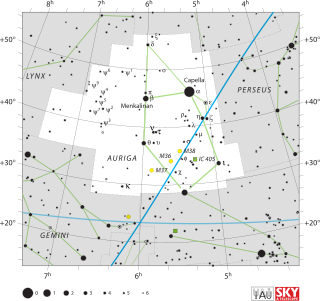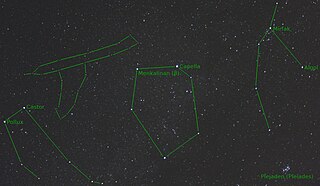Auriga is a constellation.

A chariot is a type of cart driven by a charioteer, usually using horses to provide rapid motive power. The oldest known chariots have been found in burials of the Sintashta culture in modern-day Chelyabinsk Oblast, Russia, dated to c. 1950–1880 BCE and are depicted on cylinder seals from Central Anatolia in Kültepe dated to c. 1900 BCE. The critical invention that allowed the construction of light, horse-drawn chariots was the spoked wheel.

In Sabine and ancient Roman religion and myth, Luna is the divine embodiment of the Moon. She is often presented as the female complement of the Sun, Sol, conceived of as a god. Luna is also sometimes represented as an aspect of the Roman triple goddess, along with Diana and either Proserpina or Hecate. Luna is not always a distinct goddess, but sometimes rather an epithet that specializes a goddess, since both Diana and Juno are identified as moon goddesses.

Auriga is a constellation in the northern celestial hemisphere. It is one of the 88 modern constellations; it was among the 48 constellations listed by the 2nd-century astronomer Ptolemy. Its name is Latin for '(the) charioteer', associating it with various mythological beings, including Erichthonius and Myrtilus. Auriga is most prominent during winter evenings in the northern Hemisphere, as are five other constellations that have stars in the Winter Hexagon asterism. Because of its northern declination, Auriga is only visible in its entirety as far south as -34°; for observers farther south it lies partially or fully below the horizon. A large constellation, with an area of 657 square degrees, it is half the size of the largest, Hydra.

Chariot racing was one of the most popular ancient Greek, Roman, and Byzantine sports. In Greece, chariot racing played an essential role in aristocratic funeral games from a very early time. With the institution of formal races and permanent racetracks, chariot racing was adopted by many Greek states and their religious festivals. Horses and chariots were very costly. Their ownership was a preserve of the wealthiest aristocrats, whose reputations and status benefitted from offering such extravagant, exciting displays. Their successes could be further broadcast and celebrated through commissioned odes and other poetry.
A charioteer is someone who drives one or a team of horses or other equines from a drawn chariot.

The Third Servile War, also called the Gladiator War and the War of Spartacus by Plutarch, was the last in a series of slave rebellions against the Roman Republic known as the Servile Wars. This third rebellion was the only one that directly threatened the Roman heartland of Italy. It was particularly alarming to Rome because its military seemed powerless to suppress it.

Telescopium Herschelii, also formerly known as Tubus Hershelli Major, is a former constellation in the northern celestial hemisphere. Maximilian Hell established it in 1789 to honour Sir William Herschel's discovery of the planet Uranus. It fell out of use by the end of the 19th century. θ Geminorum at apparent magnitude 4.8 was the constellation's brightest star.

Epsilon Aurigae is a multiple star system in the northern constellation of Auriga, the charioteer. It is an unusual eclipsing binary system comprising an F0 supergiant and a companion which is generally accepted to be a huge dark disk orbiting an unknown object, possibly a binary system of two small B-type stars. The distance to the system is still a subject of debate, but data from the Gaia spacecraft puts its distance at around 1,350±300 light years from Earth.

Zeta Aurigae, or ζ Aurigae, is a binary star system in the northern constellation of Auriga. Based upon parallax measurements, this system is approximately 860 light-years distant from the Sun. It has a combined apparent visual magnitude of 3.75, which is bright enough to be seen with the naked eye.

T Aurigae was a nova, which lit up in the constellation Auriga in 1891. Thomas David Anderson, an amateur astronomer in Edinburgh, reported that he was "almost certain" he saw the nova at 02:00 UT on 24 January 1892, when it was slightly brighter than χ Aurigae. He mistook the star for 26 Aurigae, although he noted to himself that it seemed brighter than he remembered it being. He saw it twice more during the following week. On 31 January 1892 he realized his mistake, and wrote a note to Ralph Copeland reporting his discovery. Professor Copeland immediately reported the discovery via telegram to William Huggins, who made the first spectroscopic observations of T Aurigae on 2 February 1892, when the star was a magnitude 4.5 object. T Aurigae was the first nova to be observed spectroscopically.

Theta Aurigae is a binary star in the constellation of Auriga. Based upon parallax measurements, the distance to this system is about 166 light-years.

Iota Aurigae, officially named Hassaleh, is a star in the northern constellation of Auriga. It has an apparent visual magnitude of 2.7, which is bright enough to be readily visible to the naked eye. Parallax measurements give a distance estimate of roughly 490 light-years from the Sun.

Eta Aurigae, officially named Haedus, is a star in the northern constellation of Auriga. With an apparent visual magnitude of 3.18, it is visible to the naked eye. Based upon parallax measurements made during the Hipparcos mission, this star is approximately 243 light-years distant from the Sun.

Sigma Aurigae, Latinized from σ Aurigae, is a giant star in the northern constellation of Auriga. It is faintly visible to the naked eye with an apparent visual magnitude of 4.99. With an annual parallax shift of 6.21 mas, it is approximately 530 light-years distant from the Earth. This is an evolved giant star with a stellar classification of K4 III.

Gaius Appuleius Diocles was a Roman charioteer. His existence and career are attested by two highly detailed contemporary inscriptions, used by modern historians to help reconstruct the likely conduct and techniques of chariot racing. He has been described in some modern sources as the highest-paid athlete of all time.

Psi4 Aurigae, Latinized from ψ4 Aurigae, is a single, orange-hued star in the northern constellation of Auriga. It is visible to the naked eye with an apparent visual magnitude of +5.02. With an annual parallax shift of 10.08 ± 0.33 mas, it is approximately 324 light-years distant from Earth.

The Charioteer Tank, or FV4101 Tank, Medium Gun, Charioteer was a post-world-war II British armoured fighting vehicle. It was produced in the 1950s to up-gun units of the Royal Armoured Corps continuing to use the Cromwell tank during the early phases of the Cold War. The vehicle itself was a modified Cromwell with a more powerful gun installed in a relatively lightly armoured two-man turret.

Uttara, also rendered Uttara Kumara is a prince of the Matsya Kingdom featured in the Hindu epic Mahabharata. He is the eldest son of King Virata and his wife Sudeshna, at whose court the Pandavas spend their one year of anonymity during their exile. His sister Uttarā marries Abhimanyu, the son of Arjuna.

The biga is the two-horse chariot as used in ancient Rome for sport, transportation, and ceremonies. Other animals may replace horses in art and occasionally for actual ceremonies. The term biga is also used by modern scholars for the similar chariots of other Indo-European cultures, particularly the two-horse chariot of the ancient Greeks and Celts. The driver of a biga is a bigarius.












